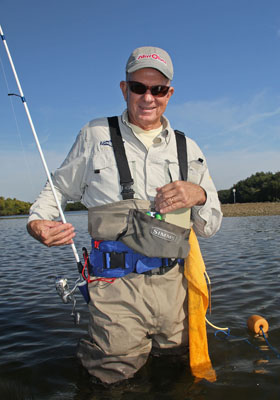Wading's Best for Winter's Extreme Low Tides
By CAPT. BILL MILLER

photo by David A. Brown |
When the water is low, that's a time for high hopes. Winter's extreme low tides offer a bounty of opportunity, but reaching and accessing this gold mine requires planning, preparation and the right tools for the job.
During the morning hours three days before and after new and full moons, tides will fall to their lowest levels of the month. Low tides can be further exaggerated by the strong winds associated with cold fronts. These heavy blows will push more water out of the bays and estuaries and hold back the incoming cycle. The resulting barrenness is called "negative low tides" and this scenario exposes much of the bottom that is rarely out of the water.
Winter fishing really gets good when falling water temperatures combined with these super low tides push speckled trout, redfish, snook, sheepshead and other flats fish into deep holes, sloughs and creeks. In some cases fish are trapped until the tide returns, so if you find these spots, you'll have a concentrated target area.
Shallow draft flats boats or airboats are the best ways to reach these honey holes during extreme tides. Airboats can glide over the exposed bottom to reach the edges of the holes. With a shallow draft boat, just get as close as possible and then wade to your spot. (Wading allows you optimal mobility to probe the area and find where the fish are concentrated.)
Winter wading exposes you to cold air and water temperatures, so dress warmly. Layer your shirts, sweatshirts and jackets so you can shed pieces as needed.
Your best bet for stability and safety over muddy bottom are stocking foot waders with neoprene booties, rather than boot foot waders. If you step into deep mud, boot foot waders often remain stuck when you try to take a step. If your foot slips out of the boot end and pulls into the leg of your waders, this can cause you to lose your balance and fall.
You don't want to risk the danger of hypothermia by getting stuck in the mud with cold water and air temperatures so use external booties, which fit snug around your ankles, so they will pull out of the mud much easier. Also, gaiters will keep sand and shell bits out of your wading booties.
A good wading belt with back support and connections for pliers, towel, a rod holder, bait bucket and stringer is very useful. Cinching the belt tightly around your waist will also keep water from flooding your waders if you stumble in the water.
To minimize fatigue and to simplify your fishing, keep your tackle selection as light as possible by thinking in advance about where you'll fish and what you'll target. I carry a small spool of leader material, a few hooks (if live baiting), leader/line clippers and three or four lures. If you're planning a long walk, you might consider a couple more baits. (Extra jig tails are a good idea.)
Chest packs are handy, but you can also just tuck your tackle into the top of your waders. A small tackle tray keeps everything organized and the wading belt prevents any items from slipping down into your wader legs.
Probably the top wading bait is a light jig with a soft plastic tail. Dark colors like root beer and motor oil are my first choices, but I'll carry a couple of light colors too. Hopping jigs along the bottom is a good bet for winter bites.
Suspending twitchbaits in baitfish colors (i.e. silver, green/silver or black/silver) will also catch winter fish, especially trout. Topwaters are fun, but fish tend to lay low in the holes during cold spells. Surface action can be minimal unless you get a warm, sunny morning.
Whatever you throw during winter, remember that slow presentations are best for cold winter fish. Live shrimp on a 1/8- to 1/4-ounce jig head is a good bet. Hook the shrimp in the head - bottom to top - and avoid the dark brain. Slowly move the bait across the bottom with occasional twitches. You might also want to suspend a shrimp under a cork in deeper spots.
Find your spots by looking on a chart or aerial photos (available online). I like scouting on a really low tide and taking note of the deeper areas that are clearly visible in these conditions. Remember the key areas for future trips and you'll catch your winter fish.
For weekly fishing reports, hot tips, catch photos and lots of angling resources, visit www.billmiller.com. For fishing charters in the Tampa Bay area, call (813) 363-9927.

